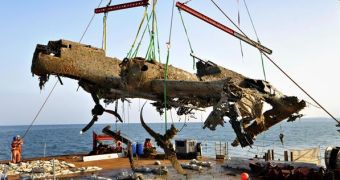On June 10, the Royal Air Force Museum announced that a German bomber had successfully been pulled from the English Channel.
The wreckage was first discovered by divers in 2008. Sonar scans carried out later on confirmed that it represented remains of the German Dornier 17, whom many preferred to call the “flying pencil” because of its narrow fuselage.
“The Royal Air Force Museum is pleased to announce the successful lift of the only known example of the Dornier Do17, from the Goodwin Sands.”
“This incredibly complex and delicate operation was made possible by a dedicated team of Museum staff and a wider group of partners and associates who gave their time, money or knowledge to help us achieve this goal,” said the Director General of the Royal Air Force Museum, Peter Dye.
The Dornier 17 dates back to World War II. It ended up at the bottom of the English Channel on August 26, 1940, after it was shot by Royal Air Force Hurricane fighters.
Of the four men aboard it at that time, two were killed in the crash and two were taken prisoners, Daily Mail reports.
Specialists say that, despite spending several decades underwater, the bomber is not as shabby as one would expect it to be. Quite the contrary: word has it that the aircraft is in remarkable condition.
In the days to come, the aircraft will be sent to a conservation center in Cosford, Shropshire.
Starting this coming weekend, members of the public will be given the chance to see the German bomber while it is undergoing conservation work.
The aircraft will eventually be put on display at the Royal Air Force Museum in Hendon, North London.
“The arrival of the Dornier 17 will be a remarkable opportunity to inspire all our visitors to discover more about this fascinating aircraft.”
“The Dornier 17 will add a new dimension to our History sessions especially those that look at Life during World War II,” the museum says.

 14 DAY TRIAL //
14 DAY TRIAL //